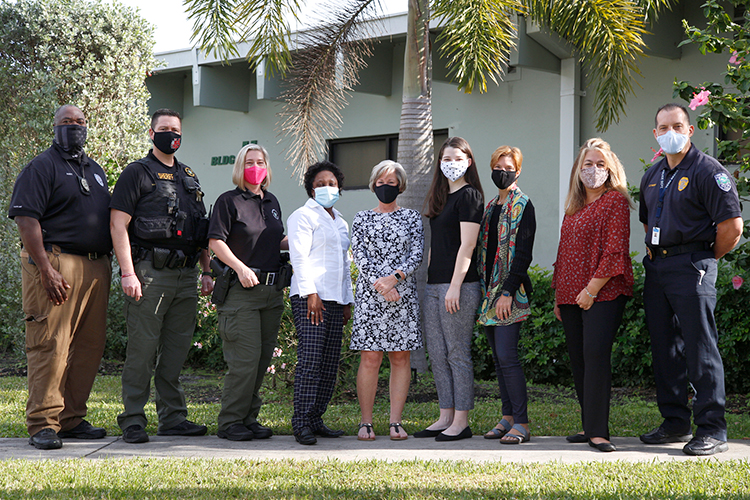The latest data from the 2020 Florida Youth Substance Abuse Survey (FYSAS), a semiannual survey, is out, and is currently being analyzed by the Substance Awareness Center and the community-led Substance Abuse Free Indian River Coalition, which falls under its auspices.
The Substance Awareness Center, which celebrated its 30th anniversary in 2020, has programs for both students and adults. Prevention Works offers school-based programs to all fifth- through ninth-grade students about the harmful effects of substances and in risky behaviors; indicated prevention programs for youth who have already engaged in risky behaviors; and community-based prevention through SAFIR. Their Recovery Works initiative for adults with substance use disorders includes day and outpatient treatment as well as recovery assistance for housing and recovery support.
The SAFIR Coalition works in tandem with SAC in terms of prevention and is comprised of key leaders in such community sectors as law enforcement, school personnel, parents, faith-based organizations, government agencies, businesses, media, healthcare agencies, youth, other organizations working to reduce substance use, youth-serving organizations, and volunteers.
“Our focus is on reducing youth substance abuse. Our main priorities are underage drinking, marijuana use, prescription drug misuse, and we work very closely with QuitDoc, which is the Tobacco Free Coalition, so that’s smoking and vaping,” explained Michele Buldo, SAFIR Coalition director. “We’re more about education, awareness, and trying to change social norms, and we advocate for putting policy changes in place.”
As an example, Phyllis Schneider, SAFIR Coalition coordinator, said they produced a brochure about the harmful effects of marijuana and driving under its influence that is now being given out at the DMV to students seeking learner’s permits or driver’s licenses.
“So that’s a policy change; it’s something that we do as a community to target a larger amount of people rather than somebody individually,” said Schneider.
“A community coalition is essential because it is data driven, focusing on local problems that require local solutions. Prevention is a partnership that works,” said Carrie Lester, executive director of SAC. “We cannot do this work alone, and through the SAFIR Coalition we can strengthen collaboration among our partners to reduce youth substance use in our community.”
The 2020 FYSAS survey of Indian River County included 389 middle school students and 425 high school students. Indications are that alcohol remains the No. 1 substance abused by teens locally (15.9 percent), followed closely by vaping nicotine (14 percent). The next three highest areas of concern are marijuana or hashish (11.5 percent), vaping marijuana (10.6 percent) and binge drinking (8.2 percent).
“We are seeing certain trends, but I think the biggest one is that the perception of harm by marijuana is going down. So, more kids are not seeing the harmful effects of marijuana as an issue,” said Buldo. She noted that a contributing factor could be a result of states beginning to legalize it for medical or recreational use.
“Michele and I usually go to the lunchrooms of high schools to engage with the youth, and it’s one of the things we hear over and over,” said Schneider. “A lot of these kids see their grandparents or their parents taking medical marijuana, so they’re thinking if it’s legal, how could it be harmful.”
However, she explained that young people are more apt to have their still-developing brains “hijacked” by addiction, whether it be alcohol, tobacco or marijuana.
“It’s that pleasure-seeking principle that they’re getting, so the brain craves more and more. When they can’t get satisfied with marijuana anymore, they go to stronger drugs like heroin and cocaine,” said Schneider.
“If you can delay that onset of when they start trying and experimenting with drugs, you have a much greater chance of preventing an addiction or a misuse or disorder later on in life,” said Schneider.
Pre-pandemic, Buldo and Schneider would regularly visit the high schools and Freshman Learning Center for a “Chat and Chew,” taking along their “carnival wheel.” Students spin the wheel and land on such categories as alcohol, marijuana, prescription drugs, smoking and vaping.
“Whatever they land on we ask them a question and if they answer correctly, we have little giveaways. We just engage with them,” said Schneider. She adds that they are amazed at how frequently the students’ answers are incorrect.
To put a more positive spin on the problem, they have started a “Most Teens Don’t” campaign with brochures indicating that in Indian River County, 84 percent don’t drink alcohol, 91 percent don’t smoke marijuana and 84 percent don’t vape.
The pandemic has curtailed some of their activities, but they hope to get back to doing small fundraisers as well as presentations and forums to educate students and the general public.
SAFIR members meet monthly (virtually for now) in six workgroups: underage drinking, prescription drugs, marijuana, tobacco/vaping, youth advisory and sustainability.
Their general coalition meetings, held every other month, are open to anyone in the community.
“We are always looking to recruit key leaders in our community and the general public to help with our mission,” said Buldo, adding that they would particularly like more parents to get involved.
“We try to use whatever strengths or passions they have,” said Schneider. She noted that membership forms are available on the SAFIR website.
For more information about SAFIR, visit safirc.org. To view the 2020 FYSAS report, visit the Florida Department of Children and Families website at myflfamilies.com.

